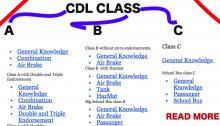- Log in to post comments

A Commercial Driver's License (CDL) is essential for those who intend to drive large or heavy vehicles in the United States. The license is required for drivers operating certain commercial vehicles, such as trucks, buses, or vehicles carrying hazardous materials. Obtaining a CDL involves passing both written and skills tests, with requirements varying by state but guided by federal regulations set by the Federal Motor Carrier Safety Administration (FMCSA).
Types of Commercial Driver's Licenses (CDLs)
There are several different classifications of CDLs, each based on the type of vehicle being operated. These classifications ensure that drivers are qualified to handle the unique challenges and responsibilities associated with different types of commercial vehicles.
Class A CDL
A Class A CDL is the highest level of commercial driver’s license. It is required for drivers who operate a combination of vehicles with a total weight of 26,001 pounds or more. This license allows drivers to operate tractor-trailers, tankers, and other large vehicles. With a Class A CDL, drivers can also tow vehicles weighing more than 10,000 pounds.
Class B CDL
A Class B CDL is required for drivers operating a single vehicle that weighs 26,001 pounds or more or a combination of vehicles with a total weight of less than 26,001 pounds. This class of license includes drivers of buses, delivery trucks, and large vehicles like dump trucks. It allows the driver to tow vehicles weighing less than 10,000 pounds.
Class C CDL
A Class C CDL is required for drivers operating vehicles designed to transport 16 or more passengers (including the driver) or vehicles transporting hazardous materials in quantities that require placarding. It is typically used for smaller vehicles that do not meet the criteria for Class A or B licenses, such as passenger vans and small hazmat vehicles.
CDL Endorsements
CDL holders may need additional endorsements to operate specific types of vehicles or carry certain types of cargo. These endorsements require extra testing and training to ensure that drivers are fully qualified. Some common endorsements include:
- Tanker (N): Required for drivers operating tanker vehicles that transport liquids or gases.
- Double/Triple Trailers (T): Required for drivers who operate double or triple trailer trucks.
- Passenger (P): Required for drivers operating vehicles designed to transport 16 or more passengers.
- Hazardous Materials (H): Required for drivers transporting hazardous materials that require placarding.
- School Bus (S): Required for drivers of school buses.
Special Restrictions for CDLs
CDL holders may have special restrictions placed on their licenses, which limit the types of vehicles they can operate or the areas in which they can drive. These restrictions are based on the individual's ability, training, or medical qualifications.
Examples of Different CDL Types and Requirements

Class A with no Extra Endorsements
Class A with Double and Triple Endorsement
Class A with HazMat
Class B without extra endorsements
Class B with Hazmat
Big School Bus class B
Class C
School Bus class C
Obtaining the correct Commercial Driver's License (CDL) is crucial for anyone planning to drive commercial vehicles in the United States. Each type of CDL comes with its specific requirements and endorsements that match the responsibilities and safety needs of different vehicle classes. Whether you're planning to drive a truck, bus, or any other type of commercial vehicle, understanding these categories and endorsements is essential for ensuring compliance with federal and state regulations and operating safely on the road.